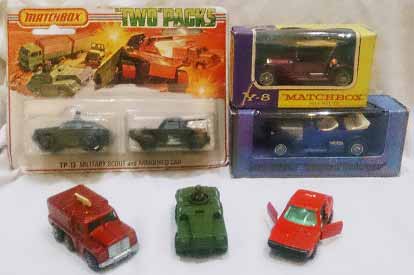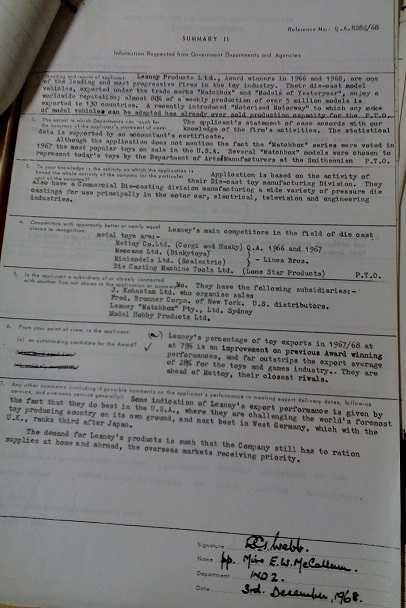
A selection of Matchbox toys manufactured by Lesney between the 1960s and the 1970s
The motto goes that that the best things come in small packages. If this is true then it must surely be applicable to Lesney Toys, the original manufacturer of Matchbox model cars. After looking at the history of the Mettoy company (the creators of Corgi Toys), it would be unfair of me not to give the same treatment to Lesney, their distinguished rivals.
As recounted by a company history detailed in a clipping from the industry magazine ‘Toys and Fancy Goods’ for May 1962 (BT 316/7), Lesney Products began in 1947. During the Second World War, company founder Leslie Smith served as a Lieutenant in the Royal Navy (he was at both Dieppe and the D-Day landings), while Jack Odell, the company’s chief engineer, served with the 8th Army in North Africa. This newspaper clipping does not make any reference to Rodney Smith (unrelated to Leslie), the other original partner in the business. Rodney left for Australia shortly after the business was founded and, by way of the combination of his and Leslie’s first names, gifted the company with their name. The article notes that after discharge from the military, the men decided to pool their wartime gratuity payments into a company producing pressure die castings, primarily for the engineering industry.
Their original operation was based in a virtually derelict pub named The Rifleman in Tottenham, North London. They began producing miniature die-cast toy vehicles as a sideline when orders for the engineering industry were low. However, the coronation of Queen Elizabeth II in 1953 encouraged sales of a die-cast replica of the State Coach. Priced at a competitive 1s 6d, and picking up on the patriotic fever of the time, this was a huge seller. It instigated a shift towards toy production, which grew over the course of the 1950s, eventually requiring them to move the company base to a larger factory in Hackney so as to house an ever-increasing workforce.
Along the way, the toy cars got smaller, so small that they would fit inside a matchbox (according to legend, Odell’s daughter inspired this when she asked to bring an item to school that was no larger than a matchbox). This was reflected in the design of their packaging and the creation of the Matchbox brand name.

Summary of Lesney’s business interests and export figures for 1967/68 (BT 316/88)
As they steered into the 1960s, Lesney’s product output exploded as they began to explore foreign markets, at one point being dubbed ‘the world’s largest car manufacturer’. In 1968 they applied for the Queen’s Award for Industry and won. The paperwork relating to this application can be found in BT 316/7 and BT 316/88.
Paperwork in BT 316/88 notes that Lesney’s percentage of exports in 1967/68 was at 79% – higher than the average 28% for the toy and game industry at the time. It’s within these pages that we also see notes pointing to issues with supply and demand, and how the desire for Lesney’s product was so great, especially overseas, that they had great difficulty in meeting all of their orders. This led to rationing of the quantities sent to retail, with the overseas orders given priority.
The paperwork mentions that Mettoy, with their range of Corgi cars, were the closest rivals to Lesney. The document records that Mettoy was also an applicant for the 1967/1968 Award for Industry, but that in terms of sales figures, Lesney was way ahead.
Perhaps the most visually interesting item in this collection can be found in BT 316/88. Enclosed within is a copy of issue one of the internal company newspaper ‘Lesney News’ dated October 1968. This records the ceremony where Lesney received their Award for Industry from Sir Gerald Templer, the Queen’s Lieutenant of the time. Also inside this publication are various illustrated features and articles about forthcoming Lesney products.
At the end of the 1960s, Mettoy tried to compete directly against Lesney with a range of toy vehicles under the brand name of ‘Husky’ which were of similar dimensions to Matchbox cars. Lesney also faced competition from overseas as Mattel, the US toy giant, unveiled its first toy cars under the Hot Wheels brand name which were also to a similar scale as Lesney’s products.
This increased competition began a difficult period for Lesney, as they attempted to hold their market position in the 1970s. Working practices changed and job losses were the result. Documents in J 149/15, CK 2/383 and J 149/4 all deal with cases of accused unfair treatment or unfair dismissal brought against the company by former employees.
In 1975 Lesney faced the Race Relations board (CK 2/383). In April, a young woman of Ugandan heritage who had formerly been employed by Lesney went into the Hackney factory to enquire about re-employment. She was told that there were no jobs available, but saw vacancies advertised outside the factory the next day. When the young woman’s family contacted the Race Relations Board, a caseworker for the organisation made a phone call to Lesney to enquire about current job vacancies. Not revealing who his employer was, he put on what was described in the document as a ‘BBC British’ accent. He was informed that there were indeed vacancies. When challenged about this incident, Lesney refuted the claim of prejudice brought against them, noting that the young woman had formerly been in their employment until she left of her own choosing, and also drawing attention to the differing ethnic backgrounds of many of their employees. Due to a lack of resolution, the case went to court, although the documentation at The National Archives does not appear to record the final outcome of the case.
As children’s tastes evolved towards more technical playthings, such as computer games, Lesney were under pressure from the same market forces as Mettoy as they neared the 1980s. Unlike their competitor’s efforts to engage the future by way of the Dragon home computer, Lesney stuck with their core business of die-cast model cars, although there was some flirtation with producing plastic model kits and pre-school toys.
The original Lesney company folded in 1982, with the Matchbox brand name going through a succession of different owners until it was finally in the possession of Mattel, the makers of Hot Wheels cars. Despite the loss of his original business, Jack Odell, returned to the die cast toy industry during the mid-1980s with a new company. Named Lledo (Odell’s surname spelt backwards). This brand offered models of vintage cars aimed at older collectors. Lledo survived until the late 1990s, when it merged with Corgi Toys, leaving the two once great rivals finally under the same roof.
Thank you for writing this, it brings back a lot of memories for me.
My childhood home was around the corner from the Lesney factory. I don’t remember hearing about the Lesney & Race relations situation, but they used to have a Christmas party for the local children every year which I always looked forward to. It was really sad when Lesneys closed down
Thanks for your memories Joanna. I think that the negative events I referred to were a rare occurrence at Lesney. There are many stories online from former Lesney employees who had nothing but good things to say about the company. These included the fleet of Routemaster buses that Lesney operated to pick up their staff for work in the morning and a policy of assisting staff members with childcare responsibilities with their school run. During the difficult financial period of the early 1970s, Leslie Smith and Jack Odell both took a serious cut to their salaries to ensure that they could continue to run the Hackney factory. There are more records relating to Lesney at Hackney Archives: http://www.hackney.gov.uk/archives (there was also an exhibition about the company held there in 2004).
Thanks again,
David
A wonderful article. Thank you, David! Matchbox cars were a huge part of my childhood. I remember clearly the first one I ever bought – a Ferret Scout Car (No. 61) – in the summer of 1964 when I was seven, followed soon after by the beautiful racing-green D-type Jaguar (No. 41). 1/11d each they were. Every year between 1964 and 1967 I would buy the new catalogue (price 3d), marvelling at the latest models but hoping that a favourite hadn’t gone out of production before I’d had time to buy it!
Thank you Ian, I’m glad this piece was able to stir up some nostalgia. If you remember those old catalogues, if you ever get a chance, have a look at the copy of ‘Lesney News’ (the internal company newspaper) we hold for October 1968, which is in document BT 316/88. Its interesting to see how Lesney was promoting its products to its staff as well as the general public.
Great article! Thanks for writing! I had loads of matchbox cars as a kid. We used to take ours into school – the size of them was perfect.
It seems like the early manufacturing of the cars turned into a real success story. It is kind of a shame that we all started playing with computers instead of cars!
Best wishes and thanks again for a great article, Chris.
Thanks for your kind words Chris.
I have a Lesney Firetruck and Dinky “light racer” plane, these belonged to my uncle and since passed on to me.. Can’t find the year of manufacture on them.. Need to know more about them.. Hope you can help?!
Hi Anto,
Thanks for your comment.
We can’t answer research requests on the blog, but if you go to our ‘contact us’ page at http://nationalarchives.gov.uk/contact/ you’ll see how to get in touch with our record experts by email or live chat.
Kind regards,
Liz.
PLEASE NOTE: Due to the age of this blog, no new comments will be published on it. To ask questions relating to family history or historical research, please use our live chat or online form. We hope you might also find our research guides helpful.